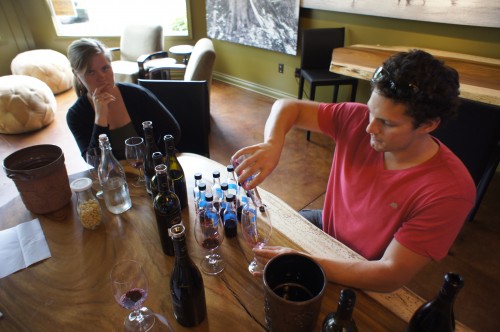
Continuing our series on wine & book pairings, we take a look at Cadaretta. I asked Brian Rudin, resident winemaker, about his choice wines and how they compliment some of his favorite reads. While the Foundry is focused on art, the folks at Cadaretta are all about the science of wine. Brian says that what sets them apart from all the other wineries in Walla Walla is their scientific approach, and a new plot of land they are developing for grapes.

To Brian, beyond the taste, what captivates him about wine is the complexity and history behind every blend and bottle. Not surprisingly, his taste in books is much the same.
What are some “can’t miss” wines you’d like to be sure our readers know about?
Cadaretta 2011 “SBS†Sauvignon Blanc / Semillon blend. We are well-known for the quality of our whites. Our white winemaking style is very different from our neighbors and friends inWashington, as we make super-crisp, racy, mineral and citrus-driven juice. We make this white blend with 75% Sauvignon Blanc and 25% Semillon. The trick is to use absolutely no oak, and to forestall the malolactic fermentation. The next wine people should seek out is our 2008 Cadaretta Cabernet Sauvignon. On reds, we have a reserved style that a delayed-gratification: this is a wine that is just starting to blossom, but will age gracefully for 10-15 years in your cellar. When a wine has the stuffing to age like that, amazing things can happen to the aromas and textures. But it has to be built sturdy for the long-haul, and this one is. This is an “archival wine†as we discussed, that will deliver a small piece of history to your senses when you open it 15 years from now. It reflects the vintage very well.

Can you recommend a wine for the following book categories – heavy, medium and light reads?
HEAVY: Reach for Cabernet Sauvignon. Like thick reading, it is not always easy at first, but tends to reward more deeply by the ending. Some messages just take time and gravitas in order to fully understand. The wines are gripping and challenging in their youth, but with time come to display their meaning with power and finesse.Â
MEDIUM: WashingtonStateSyrah: We’ll make a comparison to Chuck Palahniuk here for medium reading. It can be weird and yet enjoyable the entire ride, but will undoubtedly keep you coming back for more. The notes you detect can be funky, racy, and sometimes downright disturbing; but you will find the individualism and the honesty endlessly refreshing.Â
LIGHT: Unoaked whites and roses: a wine needn’t bowl you over with heavy themes for you to enjoy it. Unoaked whites and roses can be perfectly pleasing and refreshing, to be enjoyed in the moment while you unwind and reflect on some of the other (non-wine, non-literature) things in life.
Has there been a book you’ve read that has stuck with you? What was it and how would you describe it in wine terms? Â
A few titles come to mind. For non-fiction: “Undaunted Courage,†by Stephen Ambrose, which details Lewis and Clark’s four year expedition to be the first overland trek to the Pacific Coast of the Territiorial US and back. This one resonated with me on a personal level because Lewis and Clark passed throughWalla Wallaand theColumbiaValleyas part of their expedition. They painstakingly chronicled the geography, flora, and fauna of the land with the aim of publishing the opportunities for the American people, during the infancy of the republic. Now, 210 years later, we are still discovering the potential of this land. I never ceased to be amazed by how much we still have yet to learn about our own young wine region. We owe thanks to the people who pioneered this region, came out on foot and horse with no more than they could carry. They risked their families’ lives to have a chance at a new world. Now we are here, with a duty to do the very best we can with this gift.

For fiction, I most recently devoured “Freedom†by Jonathan Franzen. The core theme of the book is the idea that the freedom of our choices will be manifest in the lives of those we touch. Franzen takes it a little further to link the American experience, which has felt the positive and negative impacts of being populated by misfit immigrants, opportunity seekers, profiteers, sturdy industrialists, and any other castoff from Europe or beyond who didn’t have the freedom of choice in their own native land. These people came to America, populated the west and realized they could do whatever they wanted. The results could be beautiful or devastating. We are at the same juncture with wines in the New World: because in Europe, regional laws closely dictate how wines are made, down to the last details of what grapes you can use, which can be blended, when you may legally start picking, etc…. In the new world, we are only governed by the market, by what people will like and choose to buy. We are pushing the limits of what can be done with wine, and breaking a lot of rules in the process. Like the characters in Franzen’s work, the results of our choices can be beautiful or terrible. They can also be flawed, honest, and captivating.Â



